Many users cropped cameras often complain that it’s difficult to get a good picture from such a camera and that you must use full frame. Many people just drool on full-frame camerasthinking that they can do something improve their photos. And if you really want to shoot a full frame, and at the same time invest a little bag of money to purchase a camera, then this article is just for you.
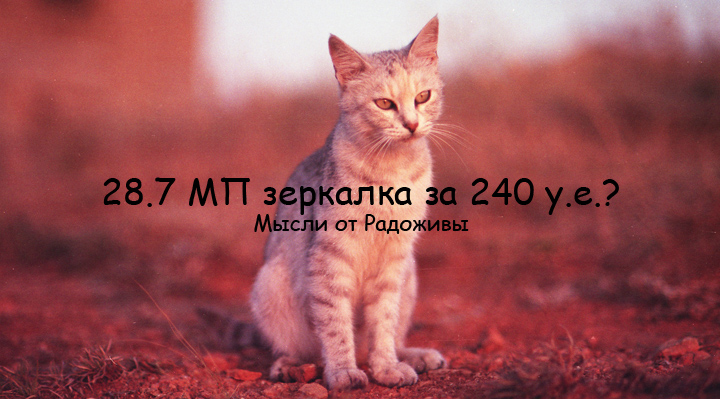
Shot on the same Full Frame :) 28 MP for 240 cu The cat is photographed in the sunset red sun.
Any good photography is based on the desire and skill of the photographer, everything else (including photographic equipment) is just a distraction from the main goal. I am often reproached for advocating to shoot with cheap equipment. I don’t actually do that, I advocate the idea that you can get a good shot from any camera if you want. Of course, the better the technique, the easier and faster the result can be achieved. Those who want to get good pictures get them from anyone, sometimes even the cheapest technique.
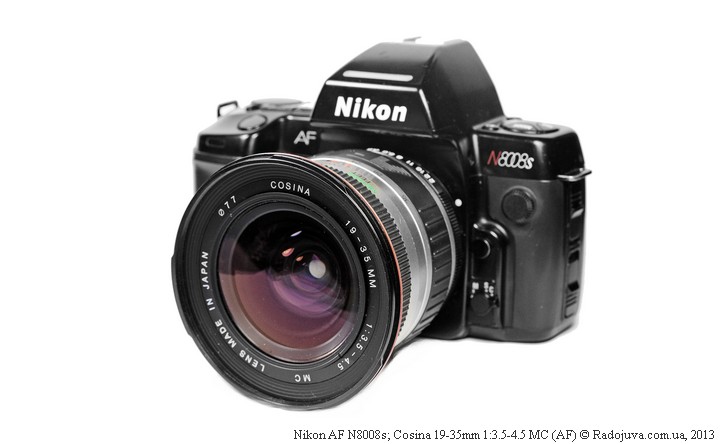
Actually, in this photo almost the whole essence of the article :)
Therefore, if there is a key aspect - desire, then for only 240 cu can:
Shoot with a full-frame SLR camera, with fast automatic focus, good serial shooting with a huge frame buffer, a huge optical viewfinder, nice controls and at the same time take pictures at 28 MP.
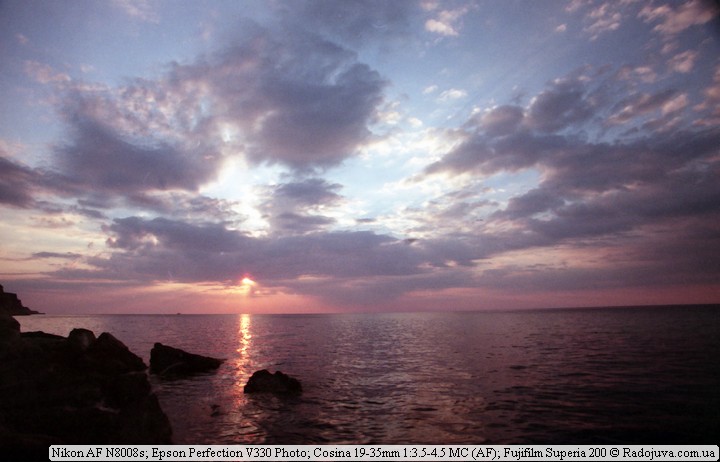
Example photo on my set. Sunset.
The secret is very simple - just use a film camera.
Many readers may think that the film camera is something terribly ancient, incomprehensible to manage, morally obsolete and unsuitable for use in the era of modern monsters Nikon D4 and Canon 1DX. In the expanses of the CIS countries such an impression people have it from the fact that in the Union and on its territory not a single SLR narrow-camera camera with automatic focus was released. Seriously, the old Zeniths do not cause any interest among young people, the main reason for which is the complete obsolescence of technology.
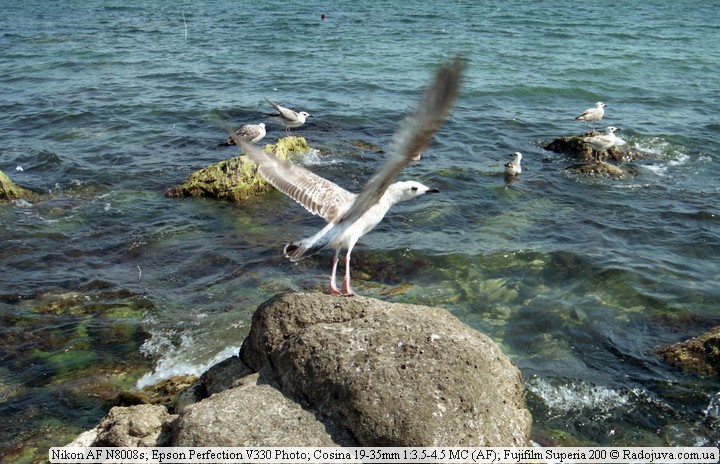
Example photo on my set. Gull
But in other countries long ago let out pretty autofocus analog volatile DSLRs with interchangeable lenses. Moreover, using such a SLR camera is no different from any modern amateur DSLR camera. Nikon D3200 or Canon 600D.
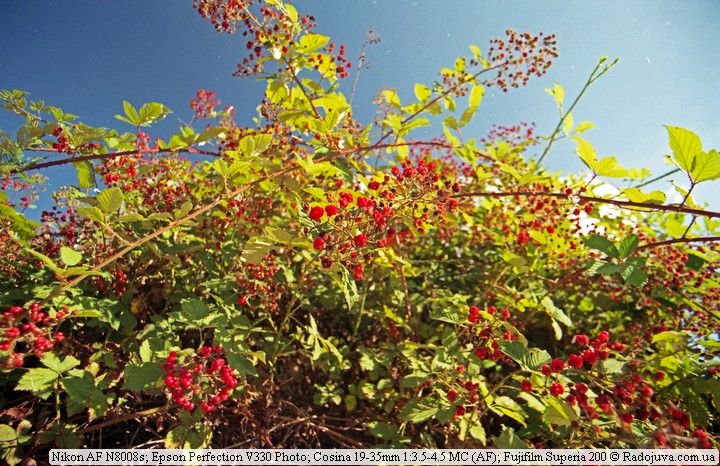
Example photo on my set. Forest Blackberry
I conducted an experiment, which cost me quite inexpensively, as a result of which this kit was assembled here:
- Nikon AF N8008s (also known as Nikon AF F801s) - 400 UAH
- Cosina MC 19-35mm 1: 3.5-4.5 (AF) - 700 UAH
- AA Batteries * 4 - 20 UAH
- 200-frame Fujifilm Superia 36 film roller - 27 UAH with free development
- Epson Perfection V330 Photo Scanner - 650 UAH
- Shipping of the camera, lens and scanner - 80 UAH
Total 1877 UAH or 235 cu In fact, I could save on the lens and batteries, since I have both. The camera, film roll and scanner cost me some 140 cu
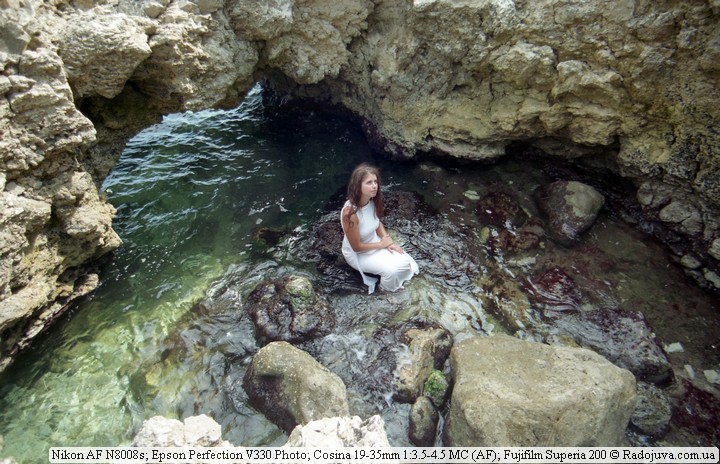
Example photo on my set. Among the stones
As a result, I got:
- A full-frame camera with a shooting speed of 3.3 frames per second. Some amateur cameras have approximately the same shooting speed. Nikon D80, D70s, D3000, D3100, and some professional CZK for 500 cu they shoot even slower, for example, Fujifilm Finepix S5 Pro.
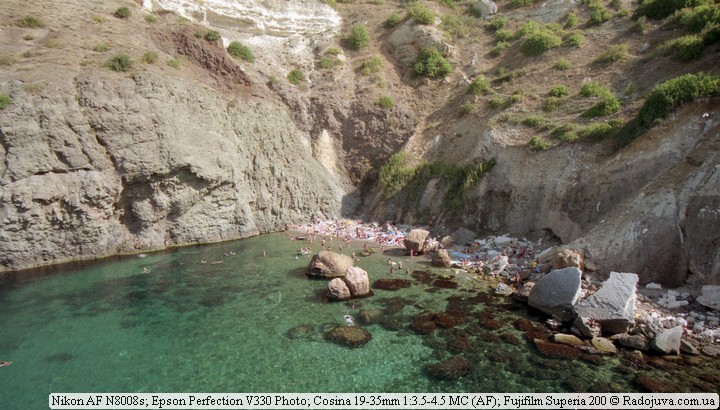
An example of a photo on a film camera. Beach.
- Maximum frame buffer makes 36 shots, for example, Nikon D7100 with the highest quality has frame buffer only 6 shots (RAW, 14-bit, lossless compression).
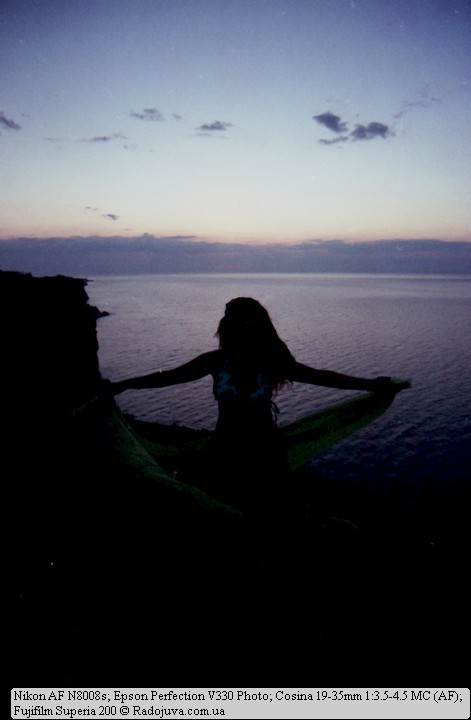
An example of a photo on a film camera. After sunset
- My camera can work out super short shutter speed equal to 1/8000 seconds, which even can not Nikon D600 и Canon 6D.
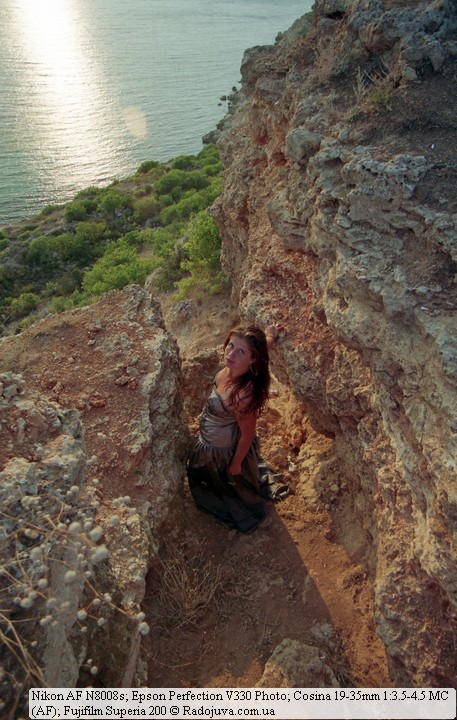
Example photo on my set. Among the stones
- A huge optical viewfinder that never dreamed Canon 70D for 1500 cu Yes, and in itself Nikon AF N8008s very good and durable camera.
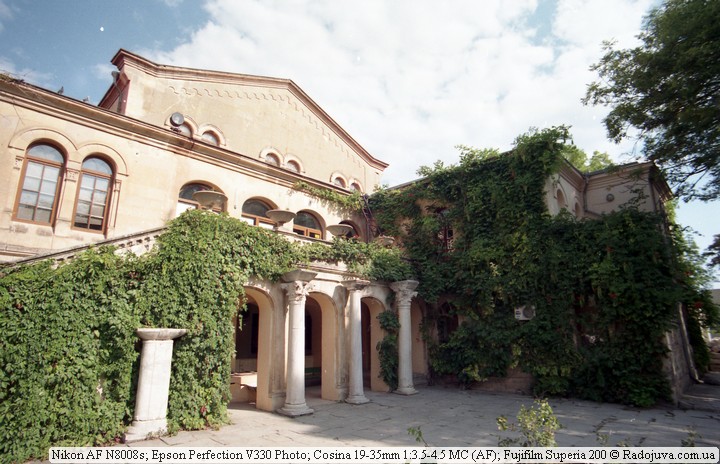
An example of a photo on a film camera. House overgrown with grapes.
- My Nikon AF N8008s it works easily with manual optics - it correctly measures exposure, has an electronic range finder, which very accurately tells about focusing. Even Nikon D5200 for 600 cu can't measure exposure with AI-S lenses.
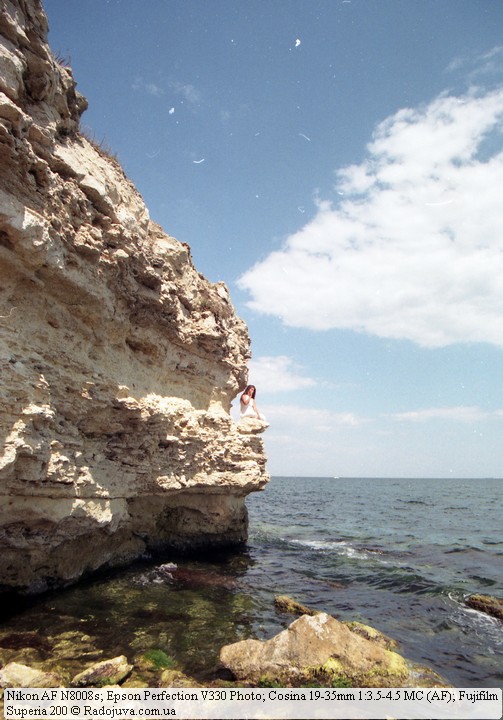
An example of a photo on a film camera. Sitting on the rocks.
- Very nice LCD in JVI, its brightness is physically (not electronically) dependent on the light source. The brighter the source - the brighter the LCD, which allows you to always clearly see the camera settings in JVI. For example, on many CZKs, I don’t see the LCD at all on a bright day or when shooting in backlight.
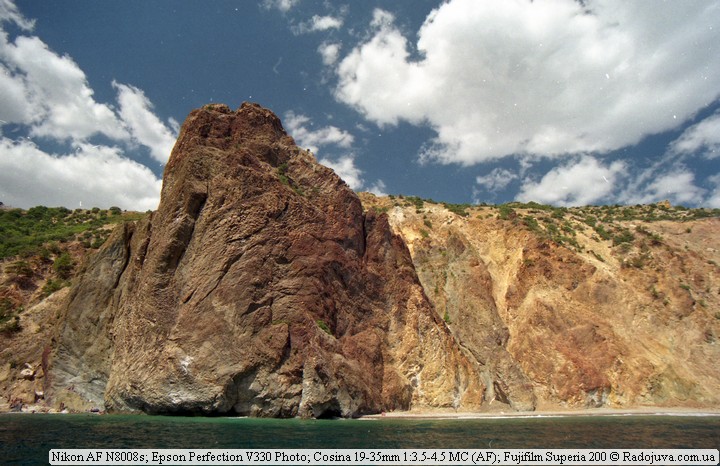
Example photo on my set. Photo from the boat
- Camera control is almost the same as that of any other Nikon CZK. When shooting, you don’t feel any difference, the whole setup is on a monochrome display.
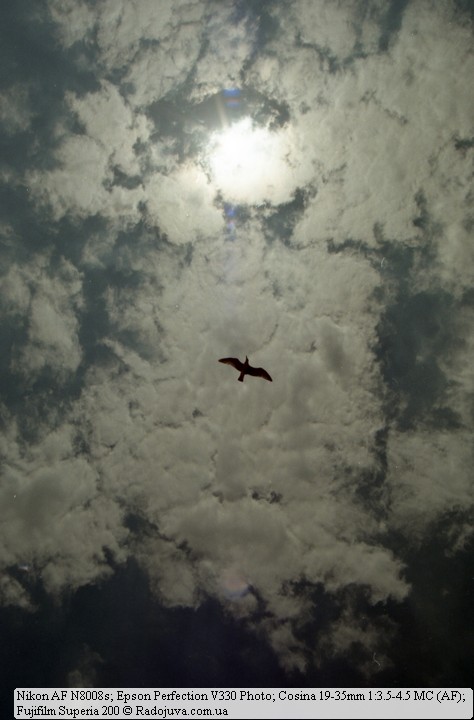
An example of a photo on a film camera. Gull
- Lens Cosina MC AF 19-35mm 1: 3.5-4.5 I just bought it for fun. 19mm at full frame can be safely attributed to an ultra-wide range of focal lengths. The lens focuses terribly fast, and with it you can create amazing pictures. To get the same viewing angle as this cheap lens gives out, on Nikon cropped cameras you should use the expensive Nikon 12-24mm F / 4.0.
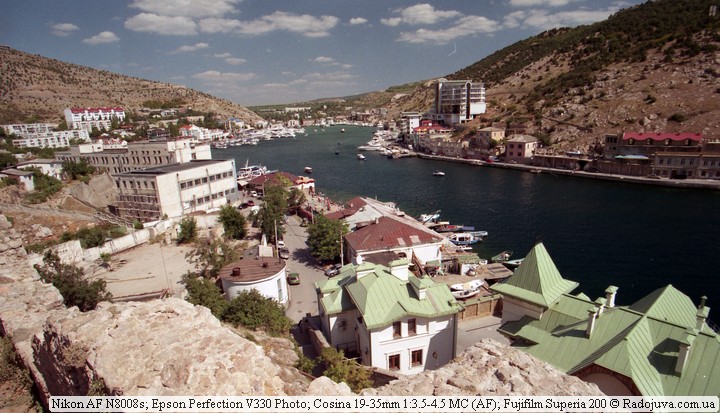
Example photo on a film camera
- A scanner in the house is also useful, for example, to digitize old photographs for an album. For example, you can scan your school diaries, and share old memories on social networks. In any case, the scanner will not be redundant.
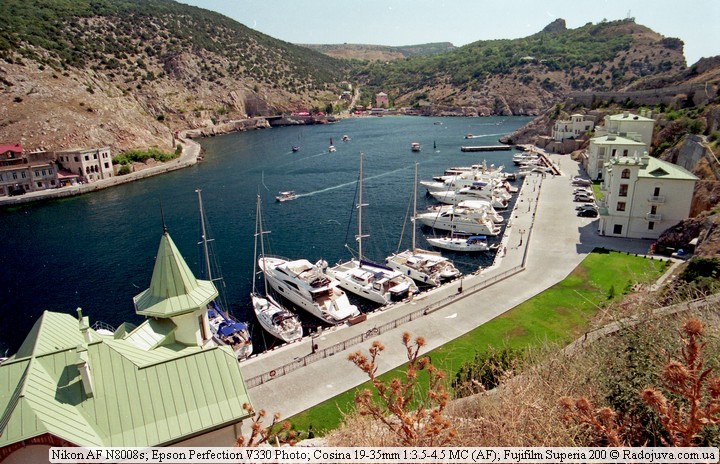
Example photo on my set. Yachts
- The scanner allows you to obtain images with 48-bit color depth. This means that each channel is encoded with 16 bits. Most 'cool modern cameras'can encode a channel using only 14 bits, and receive 42 bits at the output. Theoretically, with my scanner, you can get 64 times more shades than with any DCC.
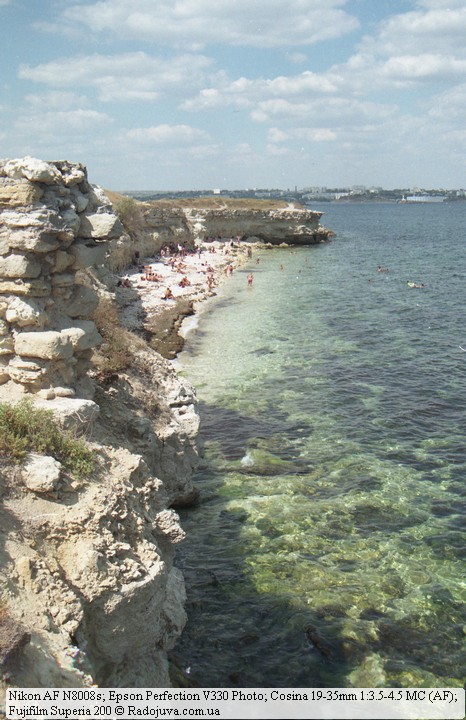
An example of a photo on a film camera. Shore
- Of course, my set has more disadvantages than advantages :), but I’ll keep silent about them in this article.
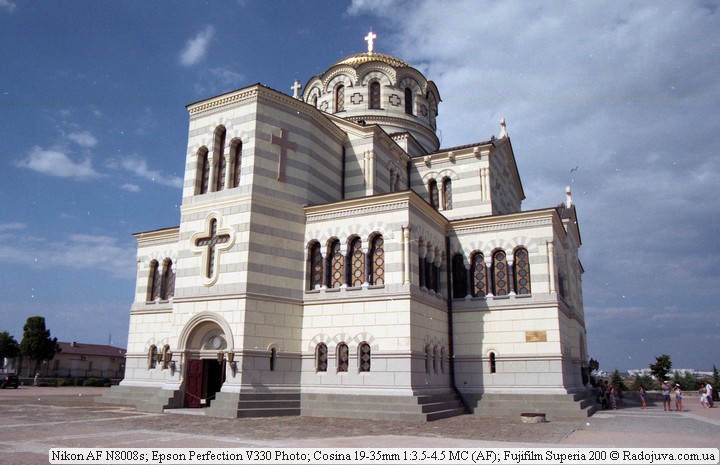
Example photo on my set. Temple in Chersonesos.
The following describes where I got 28 MP from the old film camera.
Of course, the 28MP figure in the article is a duck. But you can still get this figure in this way - the film has a physical frame size of 24mm * 36mm. Let's find the area of the film in square inches, since the parameters of the scanner are indicated in inches.
1 centimeter = 0.393700787 inches
1 square centimeter = 0.15500031000062 frame inches
1 square centimeter = 100 square millimeters
1 square millimeter = 0.0015500031000062 cpi
As a result, the film area is24mm * 36mm * 0.0015500031000062 = 1,339202678405357 sq. inch
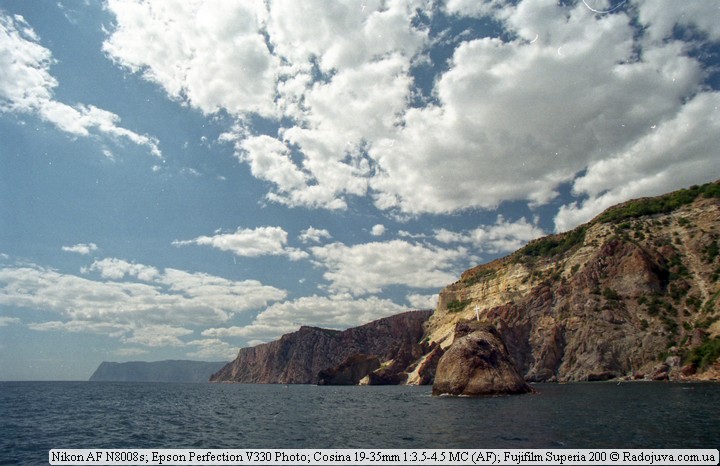
Example photo on my set. Landscape
The area of the film is 1,339202678405357 sq. inches. My scanner scans at 4800 pixels per inch, or 23 pixels per square inch. From 040 square inches of 000 pixels per square inch, 1,339202678405357 23 040 pixels are obtained, which is approximately equal to 000MP.
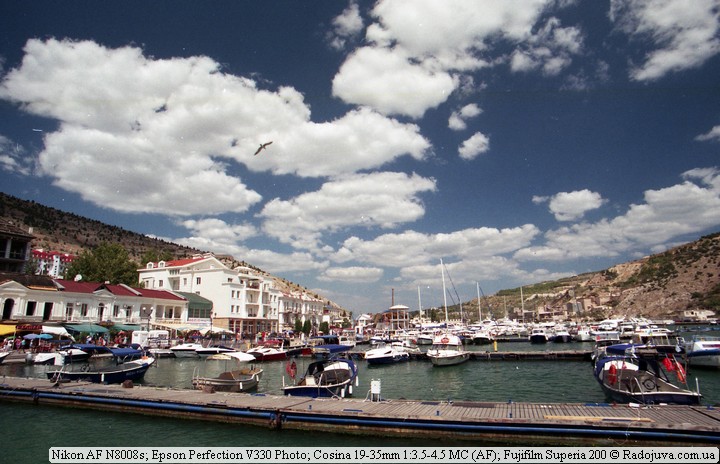
Example photo on my set. Balaclava
If your scanner has a different DPI, then the number of pixels when scanning a film frame can be calculated using the following simple formula:
DPI * DPI * 1,34
Some scanners in specifications have different DPI in height and width, for example, 4800 * 9600 is indicated in the specifications of my scanner. In fact, I can only scan at 4800 * 4800 or 9600 * 9600. The last option is half interpolation. The 'maximum possible DPI' is often indicated, for example 128000 is simply bloating the final image using a mathematical method of interpolating pixels, these numbers should not be paid attention to.
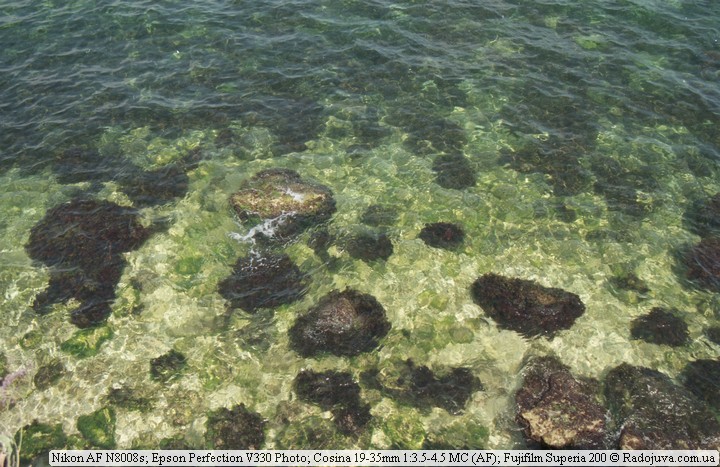
Example photo on my set. Near the shore
The simplest scanners with a slide adapter have 1200dpi, as a result, such a scanner can be squeezed out of one film shot:
1200 * 1200 * 1,34 = 1 929 600 (total about 2 MP)
I indicated '28MP camera' in the title of the article, since my Epson Perfection V330 Photo cuts off the edges of the frame a little when scanning and we end up with images not from the entire area of the film, but from a slightly smaller area. For example, a scanner often creates images like 6639 * 4319 pixels. Those who are chasing megapixels have already realized that from such a simple set you can squeeze these (or not these?) megapixels almost as much as Nikon D800 (a D800 costs almost 3000 cu).
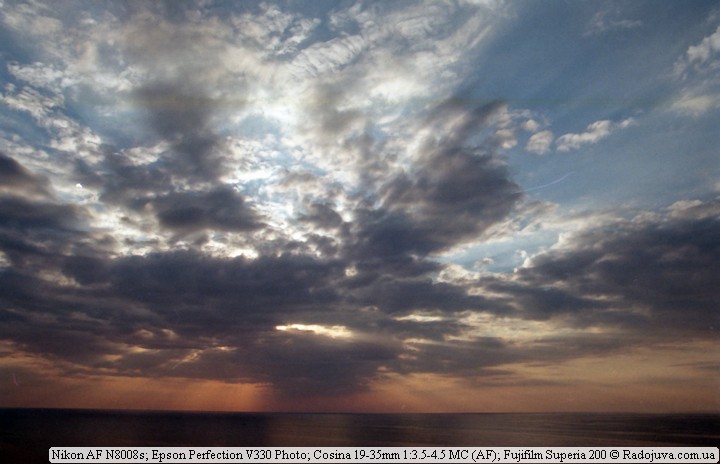
Example photo on my set. Another sunset
By itself, for serious work, such a set is no good. But the task before me was quite amateurish. For 240 cu I can enjoy a full-frame camera with convenient professional-grade control, an ultra-wide-angle lens that helped me out well on vacation and in addition I have a scanner that is convenient for scanning mail invoices :). I do not advocate fussing with a film camera, but once again I want to emphasize that there is absolutely no difficulty in working with a good analog camera. And instead of being discouraged that someone full frame, you can easily and simply shoot a full frame yourself.
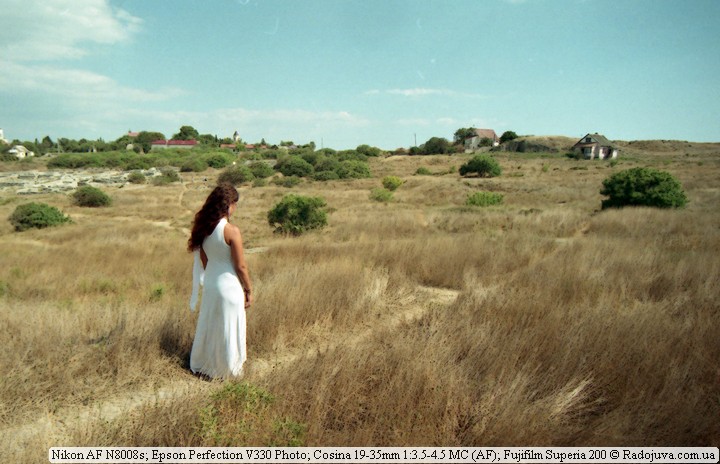
Example photo on my set. Road.
More sample photos (1400 pixels long)
Conclusions:
All of the above applies not only to my set. I brought my film set as real worldly example. Now buy used Nikon or Canon's autofocus analog camera is easy, the same goes for good-old lenses. The same story with the scanner.
Comments on this post do not require registration. Anyone can leave a comment. Many different photographic equipment can be found on AliExpress.
Material prepared Arkady Shapoval. Training/Consultations | Youtube | Facebook | Instagram | Twitter | Telegram















































I’ve been shooting the film for about 2 years, and I’m very pleased, I bought a Nikon F5 ($ 300) and a scanner ($ 1200) from Nikon Coolskan 4000. I also shoot at the number (Nikon d90). When you look at the scanned image from the slide, you experience aesthetic enjoyment of the color and texture of the image, even on a 35mm film, the volume is transferred much better! The same scinton learns on the slide without any effort, and on the modern digital mirror the Nikonovsky CMOS has piggy (color) physiognomy! Correctly exposed film image requires minimal processing, I'm on figure in landscapes sometimes arr batyvaya Photo spent more than 2 hours! Now, 5min and ready !!http://photographers.ua/photo/763589/ link HDR of 2 frames with 2 stops bracketing, slide Agfaphoto CT Precisa 100/36.
Only a week after I received it - the condition is excellent.http://www.ebay.com/itm/Nikon-Super-CoolScan-4000-ED-Slide-Film-Scanner-/121314597593?pt=US_Scanners&hash=item1c3ee9dad9&forcev4exp=true
You write -My Nikon AF N8008s easily works with manual optics - it measures the exposure correctly,…. Recently I bought the same Nikon N8008S, but he did not understand how to work with manual optics. I put on the MF Nikkor 50 / 1,8 lens, manual mode “M”, when the shutter speed is changed in the viewfinder, the numbers that I expose are visible, but when the diaphragm ring rotates, nothing happens, only this symbol “F—” flashes and more in the viewfinder (when turning the aperture ring) the line of the “+” or “-” indicator moves, as if by this it shows that there is little or a lot of light. Is that okay? If you can tell me please. Best regards, Alexander Mikhailovich.
Al. Micah. with your MF Nikkor 50 / 1,8 you have two modes of use: “M” and “A”. In the “M” mode - the shutter speed is set with the selector, and the aperture is set with the lens ring - the exposure is controlled by the indicator scale. In mode "A" only the aperture is set, shutter speed is in the automatic mode. The only inconvenience is that you need to check the diaphragm by the ring or count the clicks. Also, matrix metering does not work - only center-weighted or spot. In the net somewhere there was a Russian version of the instruction - I read it 12 years ago.
During the Soviet era, the famous photographer Plotnikov dropped a Nikon 801S - the non-American name for Nikon AF N8008s, from the balcony of the Palace of Congresses of the Communist Party of the Soviet Union and the camera continued to work with a cracked display.
Got it though?
Why, then, “the old Zeniths still do not cause any interest among young people”. Just the same cause, like lenses, in particular. At the very Zenith 19, Zenith 50mm 1.7, Helios 44-2 and Fed 2. There are still non-working ones. This technique is for those who do not have enough money for a digital SLR or who like the colors and possibilities of photographic film.
and not cheaper to buy first-fighter?
Give a link to Canon EOS 5D for 240 cu :)
having bought a nikon n90s (if there is a nikon d700, d300, d7000) - I can say one thing:!) the time spent fiddling with the film is equal to the time spent on RAW)))) and you need a very good scanner with not expired chemistry in the developer (the temperature and reagents can be adjusted) , there are many ways to develop and stylize). even the ancient nikon n90s works great with nikkor 85 1.8g though either in the manual or by shutter priority (this is how you can control the aperture). this bundle and other other fixed film cameras, coupled with a good and adequate photolab - give good results even in serious shooting
involved kit: nikon n90s, lens - nikkor 85 1.8g, Kodak Gold 200 film, developing and digitizing made on Gretag Master Flex 1008D
Maybe a little later I'm writing koment. But, yeshkin cat, a smart article. And if you take the medium format, then just do the film is not reachable by a figure. Thank you very much.
Reachable. There are Pentax 645d, Pentax 645Z, Fuji gfx 50s. True, the price is unpleasant.
And what if along with consumables count? How much is the film and its development? :-)
On average 15 tr by ad 5d. That is about 300 dollars
Nevertheless, I am waiting for a link to 5d for 240 cu
Thank you, a very sincere article.
and the colors are other natural soft without digital ringing sorry for such a comparison
I also came across a very interesting way to get a semblance of shooting on a "full frame" - adapters for cropped cameras called "Speed booster", in fact - a wide-angle converter. The adapter reduces the image given by the full frame lens to the size of the cropped sensor. At the same time, the aperture increases, the MFT improves (according to the manufacturer). Another advantage: bringing the focal length to a more suitable for crop cameras. If you are trying to use old lenses on mirrorless cameras, you need shorter focal lengths. But such lenses for a full frame were quite rare and expensive, and take 50 mm. and using an adapter is much easier to use on a mirrorless. The adapter is relatively inexpensive, I even thought to order it, but not seeing it in operation is somehow dumb :), and you have to order it somewhere in China.
I ordered one in China the other day, canon ef-Sony e. Because on a crop of native shirik is pipets how expensive.
It is hoped that sharpness will not kill fatally, because costs less than once every 7 original metabones-adapters.
Metabones, too, of course, well done, ask for $ 650 per adapter. You can buy an almost new Sony A7 for this money.
Often, for the sake of filming on Nikon FE2. I love him.
The touch screen can be used for manual focus. Manual hardware focusing is also possible, using the focus ring on the lens, with quick switching between AF and MF.
zp-mc10a-2-ste21ml
I did not think that this topic would cause so many discussions. I did not have the strength to read to the end even the first page. But be sure to read it all. Arkady, thank you very much. There should be creativity in everything. And a lot has been said in all previous comments. Good luck to you. Everything's OK.
Good article
I agree with everyone!
Very interesting article. Can I link to a full-sized JPG to see the film’s capabilities?
An ordinary tablet for a good punching of the film is not enough. Both in color and in detail.
In addition, it is now difficult to find a normal development. NORMAL for an art photo. Well, when there will be an excellent lab on the area and preferably with the possibility of optical printing, then it makes sense to bother with the film. Otherwise, the Canon EOS 5D for the same amount will have a much better overall result, and for the money saved from the film on vacation go to warmer countries.
Personally, the film was sick and I do not regret it. Recovering very quickly))
Today I specially entered the market, the local market In China (somewhere in central China, let's say) ... Surprisingly, Nikon F90X in good condition costs about 110 dollars, in normal condition you can find it for 80 dollars !!! Nikonovsky 28-105 / 3,5-4,5 in excellent condition also costs 110 dollars, and many other standard old zooms, not fast and at all 40 dollars !!! So in China, a wonderful film system can be assembled for $ 120-170. Strange, but the Nikon F100 also cost about $ 270 in perfect condition !!! The new Nikon F5 costs about $ 400 and the Nikon F4 about $ 250. Many years ago I did not even dream of such cameras, when I bought the Nikon F90x I thought that I was on the moon, although then I shot a lot on the F100 and left an extremely pleasant experience. But my latest Olympus OM-4Ti was the best? this was the camera, it seems like no one else has inserted such a large viewfinder with such a high magnification into the camera, and also in such a small body. If anyone has not seen, try when you get the opportunity ...
In Russia, the exact same prices. What year these flea market cameras are covered with dust)
Itself worked on F90, F80 and F100. Very worthy devices. With high-quality film and development, they give birth to masterpieces with one button, even in the hands of 8-year-old children.
But is it possible to put several scanned landscapes in the original resolution here?
film natural post production is very enjoyable!
thanks for the reviews!
What is young people not interested in? I’ve been shooting a Canon 12D for 450 years with Tamron 28-75 F2.8, Zenit 11, Zenit E. In addition to all this equipment, there is Zorkiy 4, but I don’t use it, because it’s not a SLR camera, there is an M39 and no light meter there.
As a light meter you can use, for example, your Canon 450D. Or the same smartphone. I say this as the owner of Zorkiy-4 :))
Hello, of course I’m writing a little late (a year later, after all), but can I talk to you somewhere in social networks? ;)
Just looking after Nikon F3 or something like that from the 80s to take with me to reconstruction events. So that it was atmospheric, and entourage, and photos :)
The author is well done, he made an excellent article! More than 4 years have passed, but similar topics are still being raised. And the pros use the “double-crop” to the full, and the thumbnails are in compacts, and the phones take pictures of comparable quality (not counting the depth of field). And young, weak minds are still trying to deceive the laws of the market. Get more and preferably for free))
All these mythical film colors, lamp grains, oil plasticity ... Alas, the only thing missing from the digital camera from film times is a large and light viewfinder! Mirrorless cameras have eliminated this lag. Now the tape is deader than dead. There are no more photo labs left. And if we are to fool with chemistry - then only LARGE FORMAT! That's where the full immersion in history is! This is where the noticeable difference lies!
Photos of Balaklava Bay are mirror-like (I suspect that they are not the only ones). By the way, I often come across such "reflected" scans, which can be attributed, albeit insignificant, but still the disadvantages of digitizing photographic films.
Dear Arkady! With constant pleasure I read (and re-read :)) your blog. Among other things, it gives a constant charge of positive and optimistic.
This is probably the third time I come across this article. I want to add that the deformation and graininess of the film will also affect the resolution of the image. When I set out to overtake the old archive into digital, I used scanners (Epson Perfection 2450 and v750pro - perhaps better, only drum-type ones) and a reproduction setup (for light) with a Canon EOS 300D camera (6 mPix). So, on old slides ORWO (home processing) analog grain climbs already when scanning at 1200 Dpi. Slides and negatives from the early 90s, processed (processing according to E-6 and C-41 in laboratories) give a noticeably better result, but also do not overlap 6 mPix. True, this may also be due to unsuccessful long-term storage ...
How much does a film clip of decent quality, not expired (is it important?) For 36 frames now cost? Are they generally available? 2019 makes its own adjustments….
Quite affordable. 800 - 1000 RUB
KODAK GOLD 200_36 can be found for 500-600 rubles for a new video.
kotofei asked about the worthy, I wrote about the worthy.